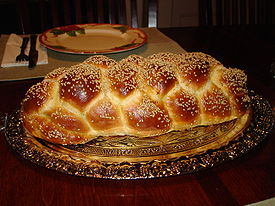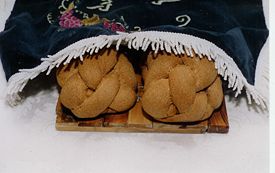- Challah
-
Challah (also ḥallah plural: challot/ḥalloth/khallos) (Hebrew: חלה) also [1] khale (eastern Yiddish),(German and western Yiddish), berches (Swabian), barkis (Gothenburg), bergis (Stockholm), chałka (Polish), vánočka (Czech), zopf (Switzerland) and kitke (South Africa),[2] is a special braided bread eaten on the Sabbath and holidays.
Contents
Religious significance
According to Jewish tradition, the three Sabbath meals (Friday night, Saturday lunch, and Saturday late afternoon) and two holiday meals (one at night and lunch the following day) each begin with two complete loaves of bread.[3] This "double loaf" (in Hebrew: lechem mishneh) commemorates the manna that fell from the heavens when the Israelites wandered in the desert for forty years after the Exodus from Egypt. The manna did not fall on the Sabbath or holidays; instead, a double portion would fall the day before the holiday or sabbath.[4]
Ingredients and preparation
Traditional challah recipes use a large number of eggs, fine white flour, water, yeast, and sugar. Modern recipes may use fewer eggs (there are also eggless versions) and may replace white flour with whole wheat, oat, or spelt flour. Sometimes honey or molasses is substituted as a sweetener. The dough is rolled into rope-shaped pieces which are braided and brushed with an egg wash before baking to add a golden sheen. Sometimes raisins are added. Some bakers like to sprinkle sesame or poppy seeds on top for flavor.
Challah is usually parve (containing neither dairy nor meat, important in the laws of Kashrut), unlike brioche and other enriched European breads, which contain butter or milk.
Hafrashat Challah ritual
Main article: The Mitzvah of ChallahThe term challah also refers to the Mitzvah of separating a portion of the dough before braiding. This portion of dough is set aside as a tithe for the Kohen.[5] In Hebrew, this Mitzvah is called "hafrashat challah."
Traditional Shabbat meal
It is customary to begin the Friday night meal and the two meals eaten during the Sabbath day with a blessing over two challot. After kiddush over a cup of wine, the head of the household recites the blessing over bread: Replace "HaShem" and "Elokeinu" with the appropriate pronunciation. "Baruch atah Adonai, eloheinu melech ha'olam, hamotzi lechem min ha'aretz" (translation: "Blessed are you, Adonai, Sovereign of the universe, who brings forth bread from the earth").
Special challot
Rosh Hashanah
On Rosh Hashanah, the Jewish New Year, the challah may be rolled into a circular shape (sometimes referred to as a "Turban Challah"), symbolizing the cycle of the year, and baked with raisins in the dough. Sometimes the top is brushed with honey in honor of the "sweet new year."
Schlissel challah
For the Shabbat Mevarchim preceding Rosh Chodesh Iyar — i.e., the first Shabbat after the end of the Jewish holiday of Passover — there is a custom of baking schlissel challah ("key challah") as a segula (propitious sign) for parnassa (livelihood). Some make an impression of a key on top of the challah before baking; some place a key-shaped piece of dough on top of the challah before baking; and some bake an actual key inside the challah.[6]The earliest written source for this custom is the sefer Ohev Yisrael by Rabbi Avraham Yehoshua Heshel, the Apter Rav. He calls schlissel challah "an ancient custom," and also offers several kabbalistic interpretations. He also writes that after spending forty years in the desert, the Israelites continued to eat the manna until they brought the Omer offering on the second day of Passover. From that day on, they no longer ate manna, but food that had grown in the Land of Israel. Since they now had to start worrying about their sustenance rather than having it handed to them each morning, the key on the challah is a form of prayer to God to open up the gates of livelihood.[6]
Challah rolls
Shabbat Challah rolls, known as a bilkele or bulkele or bilkel or bulkel (plural: bilkelekh; Yiddish: בילקעלע) is bread roll made with eggs, similar to a challah bun. It is often used as the bread for Shabbat meals or for meals during the Jewish holidays.
Mizrahi Jewish custom
Mizrahi Jews have no tradition of using a braided loaf. Instead, the Middle Eastern Mizrahis use a flat bread resembling pita. In some traditions twelve pitta breads are used, to represent the twelve loaves of showbread in the Temple. They are arranged in two layers in the formation :••:, with the central two breads of the upper layer used for the blessing. Mizrahis of Central Asian-Bukharian descent eat a bread called leeposhka.
See also
Citations and notes
- ^ Volume III of the YIVO Institute for Jewish Research’s Language and Culture Atlas of Ashkenazic Jewry devotes nine pages, complete with linguistic maps and charts, to the various names for Sabbath and festival breads in Central and Eastern Europe. Although “challah” is predominant in the United States, berkhes, dacher, koylatsh, shtritsl and kitke are common in other parts of the Jewish world. Forward. The Jewish Daily, Nov 18, 2005
- ^ South African Challah?, Forward.com. The etymology is given as "Kitt" + "-ke": "Kitt" in German means “putty" [1]; "-ke" is the Slavic diminutive suffix found in many Yiddish words and names. Kitke referred not to the whole challah but simply to the braids or decorations that were attached to the challah like putty before baking, and the word must have originally referred to these.
- ^ Maimonides (d. 1204), Mishneh Torah Hilchot Shabbos, Chapter 30, Law 9. (Hebrew)
- ^ Sol Scharfstein, Understanding Jewish Holidays and Customs, page 16 (1999)
- ^ (Numbers 15:17-21)
- ^ a b "Second Thoughts: The Key to Parnassah." Hamodia, Feature Section, p. C3. 2009-04-23.
Shabbat • שבת Prayers/Rituals Baqashot • Haftarah • Kiddush • Jewish services • Lekhah Dodi • Maftir • Seudah Shlishit • Shalom Aleichem • Torah reading • Triennial cycle • Yedid Nefesh • ZemirotFood Objects Laws Biblical Sabbath • Cooking on Shabbat • Driving • Electricity • Eruv • Eruv tavshilin • Eruv techumin • Muktzah • Prohibited activities • Rabbinically prohibited activities • Shabbos goy • Shomer ShabbatInnovations Shabbat clock • Shabbat elevator • Shabbat lamp • Shabbat microphone • Shabbat mode • Shabbat module • Shabbat pedestrian crossingSpecial Shabbat Motzei Shabbat Categories:- Yeast breads
- Jewish breads
- Shabbat food
- Jewish cuisine
- Jewish ceremonial food and drink
- Holiday foods
Wikimedia Foundation. 2010.



